Midtown Manhattan’s side streets can be lined with ancient structures, but they have come to hide their antiquity well. In the go-go real estate world, busy, commercial neighborhoods call for the new, the now, the happening. Old signs are removed or covered with new vinyl signs lest things appear too aged. Storefronts are updated. Building fronts are covered over in modern guise, or, especially in the Times Square area, dominated by billboards, some of which are neon-lit or video (in fact, a certain amount of neon billboards are lit up by governmental decree).
However, on a recent weekend, while skulking and drifting sullenly in Midtown, I found a street that has not completely deserted the ways of previous decades.
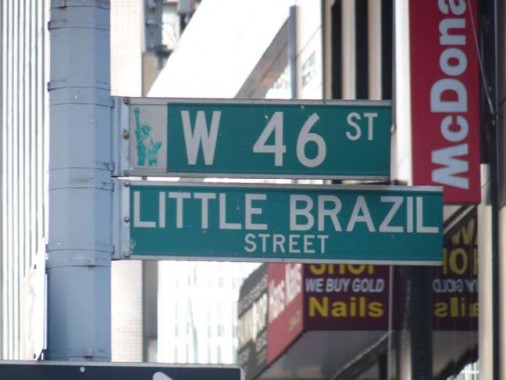
West 46th between 5th and 6th Avenues is touted as Little Brazil Street. I counted only 2 or 3 Brazilian restaurants on the block. This section of Midtown, though, used to be home to many Brazilian immigrants (who mostly are found in Astoria these days). There’s a local newspaper, The Brazilians, whose online version hasn’t been updated since 2011; its offices are at 21 West 46th. The Brazilian Consulate has offices on 6th Avenue near West 46th. And that’s about it.
Brazilian Independence Day, which is in September, is celebrated on the block each year.

Via Brasil, at 34 West 46th since 1978, is the best-known Brazilian restaurant on the strip. The reviews are hit and miss. Brazil’s language, Portuguese, spells the country’s name with an S.
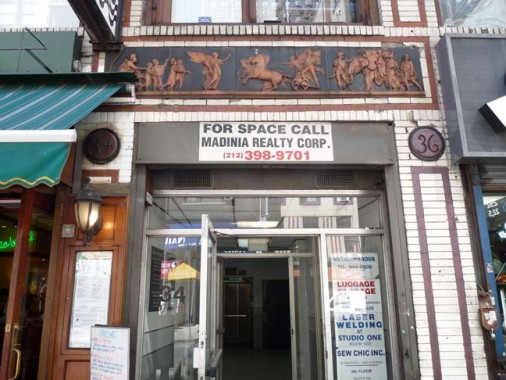
It’s the building, 34-36 West 46th, that intrigued me, though. It’s a terra cotta tour de force and even boasts some classic stenciled window ads for who knows how many decades ago.
According to NY Times architecture expert Christopher Gray, the imaginative building went up in 1914.

It’s home to Metalliferous, described on its website as “a full-service, fully-stocked supplier of metal, tools, and supplies to jewelers, beaders, crafters, hobbyists, metalworkers, sculptors, and everyone else interested in metalworking and jewelry.” The Diamond and Jewelry District is one block to the north on West 47th between 5th and 6th.
“Ferrous” means made of iron; iron’s chemical symbol abbreviation is Fe, from the Latin word ferrum. (Iridium is abbreviated Ir.)
Meanwhile, in Comments:
The word “Metalliferous” does not refer to iron. The root “fer” means “carrying,” as in containing. “Metalliferous” means that it has metal. For a similar use of that root, you might be reminded of the Carboniferous period of Earth’s history, marked by the large amount of carbon in the corresponding part of the fossil record – that layer contains a lot of carbon.

The house numbers, 34 and 36, are rendered lovingly in magenta terracotta on either side of the entrance.
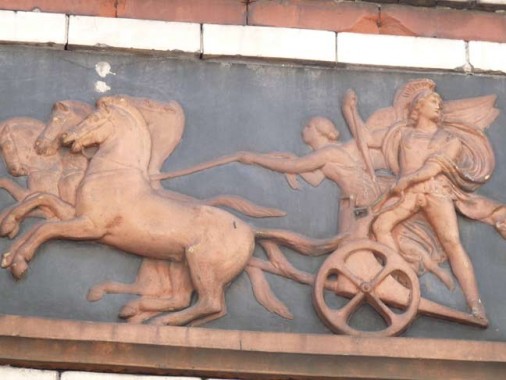
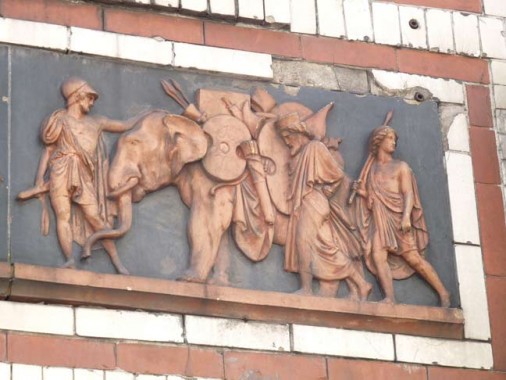
The terracotta scenes on the frieze above the door are a mystery to me. To view the whole scene, see the photo above of the front entrance. An angel seems to be attempting to prevent an invasion by a chariot-led force that also included a pack elephant. From my high-school history, I’m aware that the Carthaginian general Hannibal (247-182 BC) tried to invade Rome from the north, using elephants trained to charge the enemy; he came the closest of any foreign invader to defeating the empire until its decline began in the 400s AD. The Romans used war elephants in their own right after the Carthaginian challenge was repelled and their capital was levelled in 146BC.
Hannibal was a badass in imaginative ways:
In the 184 B.C. battle between King Eumenes II of Pergamon (r. 197-159 B.C.) and King Prusias I of Bithynia in Asia Minor, Hannibal served as commander of the Bithynian fleet. Hannibal used catapults to hurl pots filled with poisonous snakes into the enemy ships. The Pergamese panicked and fled, allowing the Bithynians to win. Ancient History
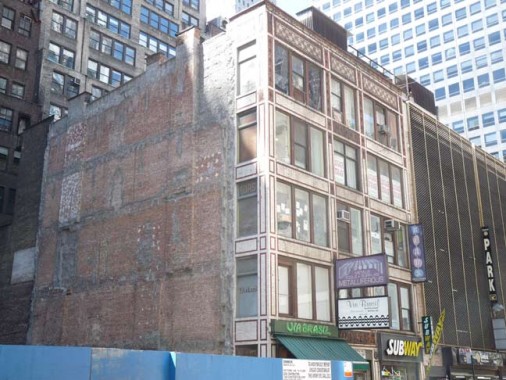
A teardown next to 34-36 West 46th serves to emphasize some stenciled window signs that were placed there no later than the 1940s, in my guesstimate… Note the parking garage next door. No architect has yet succeeded in building an attractive parking garage.
The topmost (5th floor) says “Lisa” along with the cities NEW YORK and PARIS. Also displayed are the words “robes et…” (“dresses and…”) and something I can’t make out. The 4th floor window has something unintelligible. The 3rd floor window: “FURS/Wm. C. /EMERICK/MAERLENDER”. On the 2nd floor is “TAILOR.”
Across the street at #33 is another terra-cotta front building from 1916, this time in pure white, featuring playful human figures, some with wings, some not. All have facial expressions denoting dyspepsia to one degree or the other.
The terra-cotta hit parade continues at #21 West 46th. It was likely constructed between 1925 and 1935; its stepped-back roof and colorful terra-cotta panels attest that even some of the most utilitarian office towers built in that era were given a little extra something to add pizazz.

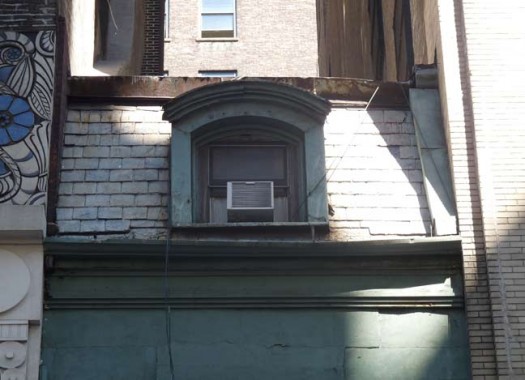
Then there’s the strange case of #19 West 46th. At 12 1/2 feet in width it could be the second narrowest house in Manhattan. (The narrowest is #75 1/2 Bedford Street in Greenwich Village, which measures 9.5 feet in width. It was briefly home to famed poet Edna St. Vincent Millay, and at a different time, anthropologist Margaret Mead.
This building, though, has its own stories. It was once part of a matched set, as its twin, 17 West 46th, was torn down decades ago. Manhattan building lots were sometimes sold in 25-foot-wide parcels and in this case, a developer chose to build two narrow houses instead of one wide one. There’s one apartment per floor, but all have two bedrooms.
According to NY Times architecture expert Christopher Gray, the narrow house was built in 1865, soon after West 46th itself came into existence.
472 Broadway, downtown, is also rather narrow.
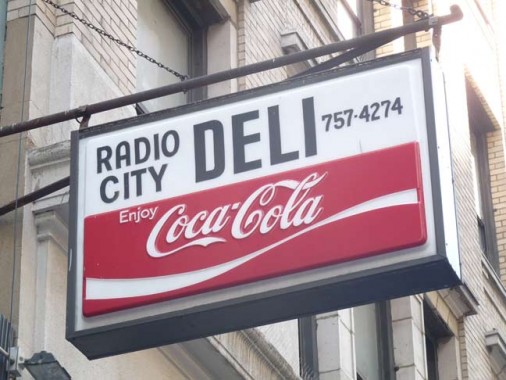
The Radio City Deli has been replaced by the Akdeniz Turkish restaurant, but its illuminated sign featuring the Mobius Coca-Cola symbol, is still hanging over the sidewalk. I wonder if it lights up at night.
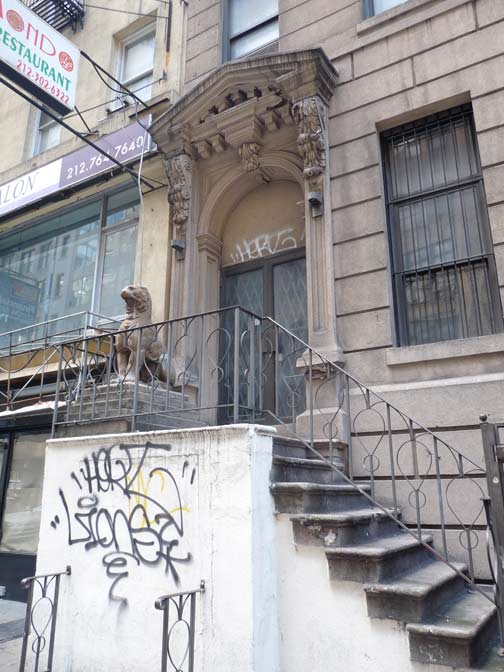
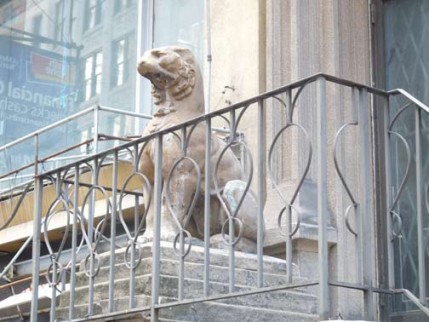
Also notable is the deteriorated brownstone townhouse at #7 West 46th, which has seen plenty of better days. Before going through the front door, you have to get past a creature of some kind, likely a lion. If it were sculpted with 3 heads, you could call it Cerberus.
An entrance under the front stairs has been bricked up.
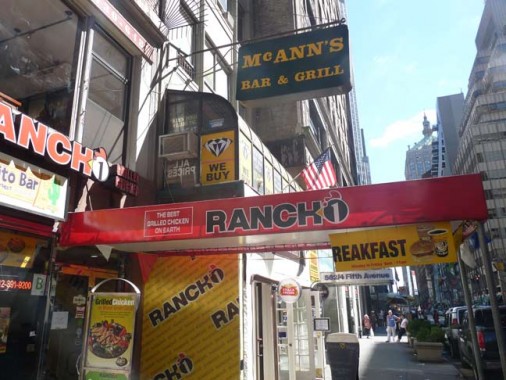
Have I found the last remaining Ranch 1? They used to be ubiquitous all over town. I liked their grilled chicken sandwiches with a multiple choice of sauces and great fries.
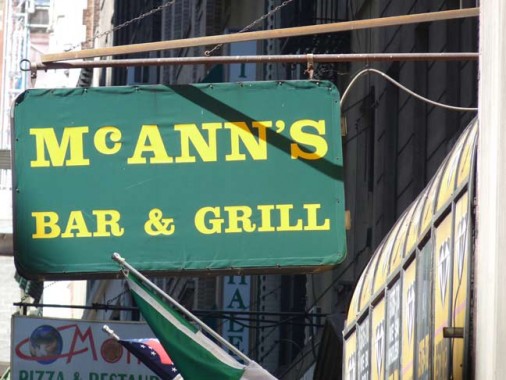
I can’t find a thing on McAnn’s bars on the web, but like Blarney Stone, they used to be fairly frequent around Manhattan. There was one in Penn Station and another in a different depot I can’t remember. I seem to recall a cavernous space with very little light. Anyone have their own McAnn’s story?
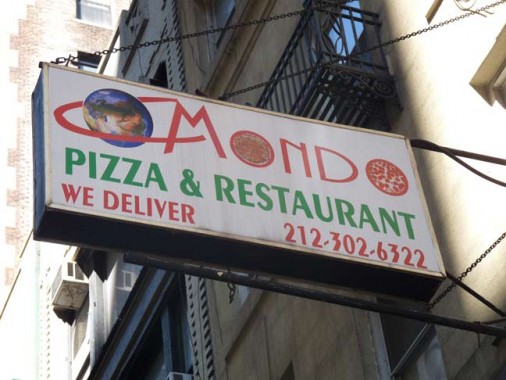
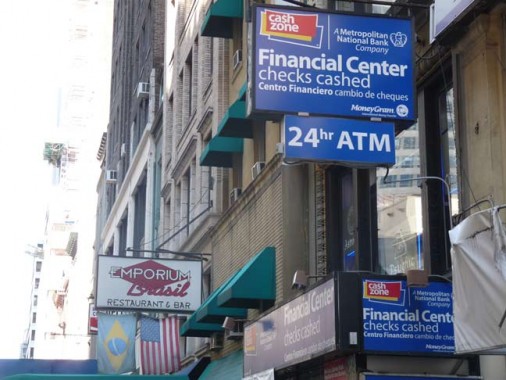
There are perhaps as many as 10 overhanging neon signs on the block, an unusual concentration.
#2 West 46th is a massive office building, but in the early 20th Century, even these had decorative touches.
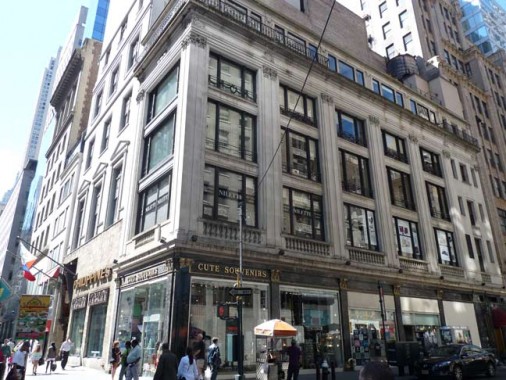
There’s nothing cute about the 5-story pilastered building on the SW corner of the Queen of Avenues and West 46th, and the developer and architect would probably express some objections if they knew an establishment selling “cute souvenirs” would occupy the ground floor in 2012.
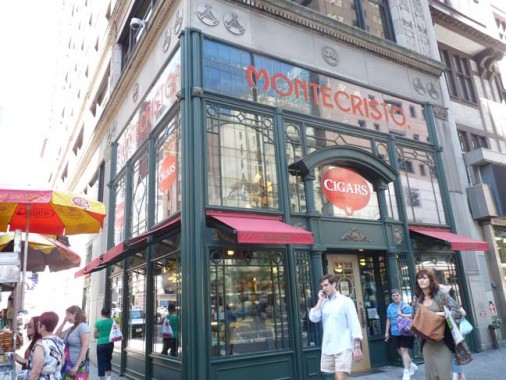
5th Avenue has always featured cigar emporia. Nat Sherman — whose TV commercials I still remember (“to share happy days with you gives me great pleasure”) — held down a featured spot at 5th and West 42nd for many years.
Montecristos are made in Cuba and the Dominican Republic, and I suppose the latter are sold here.
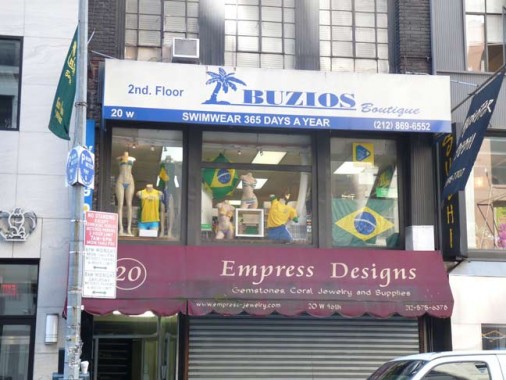
I then made my way west along West 46th again. Buzios, at 20 West 46th, features swimsuits the Girl from Ipanema might wear. A bit of Brazil, still hanging in there.
Former High School of the Performing Arts, now Jacqueline Kennedy Onassis High School for International Careers, 120 West 46th. One of prolific schools architect C.B.J. Snyder’s greatest Romanesque Revival creations, it went up in 1893-1894 — and it was his first public school. The school and the block were well-known in the 1980s when the TV show Fame was based on this school and exterior shots were done on the block.
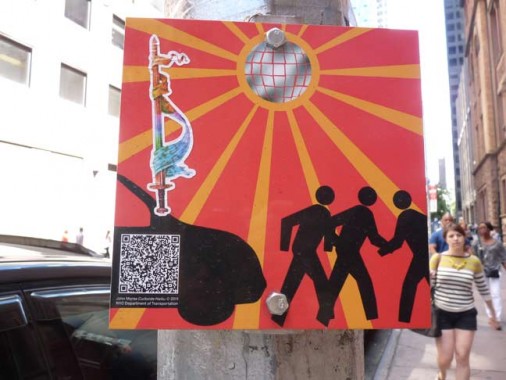
A number of imaginative signs telling bicyclists and pedestrians to be careful have appeared all around town. Some feature haiku while this one is readable only from a smartphone, a device I do not own.
So, what does it say?
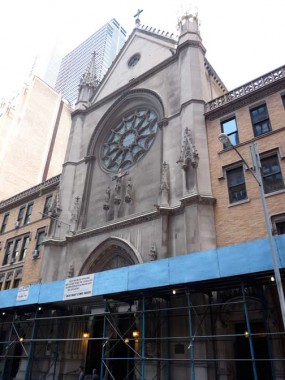
Anglican Church of St. Mary the Virgin, West 46th between 6th and 7th. The church was founded by Father Thomas McKee Brown in 1868, with the cornerstone laid for this building in 1894 [Napoleon LeBrun, architect]. A High Church, it uses a number of rituals that are associated with the Roman Catholic Church.
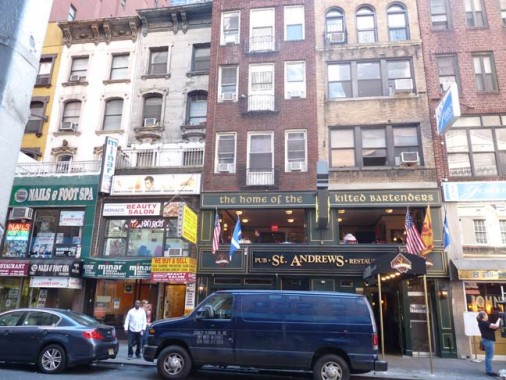
This stretch of West 46th has some aged buildings as well, some of which go back to the late 1800s.
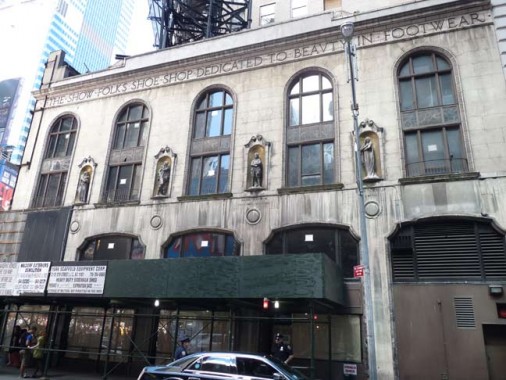
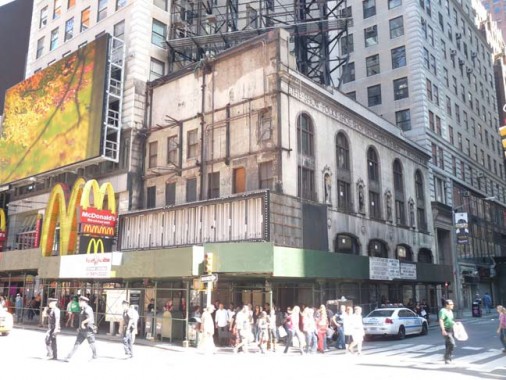
For the first time in quite a while, the ancient I. Miller Shoe Store on the corner of West 46th and Broadway, has its frontage along Broadway exposed to the world, but it’s nothing to write home to Mother about as most of the exterior ornamentation has been shorn off over the years. For over a decade the ground floor hosted a TGI Friday’s, and a giant ad billboard dominted the corner (see this page for an image).
Statues of four Broadway and film actresses, singers, and dancers are still found on the West 46th Street side, though compromised; hopefully, there will be a movement to restore them soon.

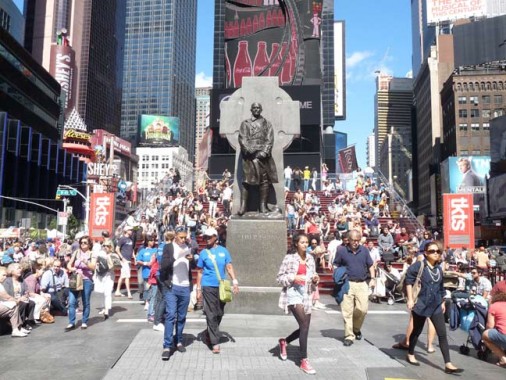
Statues of impresario George M. Cohan and Father Francis Duffy have been re-bronzed and preserved to be enjoyed by future generations. The stories behind the statues, and the I. Miller store, are on my Times Square Who Are Those Guys and Gals page.
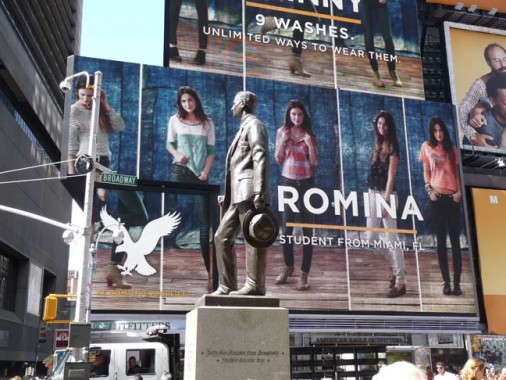
George M. manages to stay in the picture in this giant video billboard.
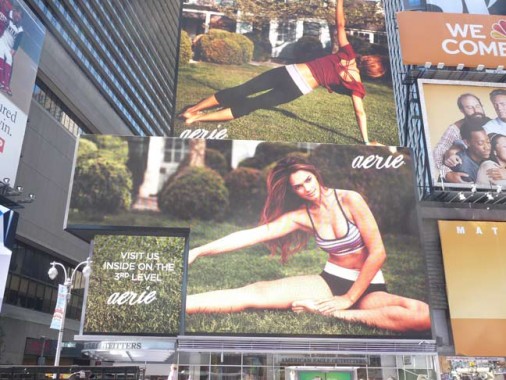
Though hardcore porn was chased out of the Times Square area during the Rudy Giuliani purge of the mid-1990s, some of the giant video ads make use of an insidious form of soft porn to advertise wares.
While making my way west on W. 46th, I passed the NYC headquarters of Scientology, whose tenets read like a science fiction book, and with good reason: the ‘faith’ was founded by sci-fi author L. Ron Hubbard. The building has also been home to the 7th-Day Adventists and a young Cary Grant. Because of the harsh shadows I didn’t get a good photo.
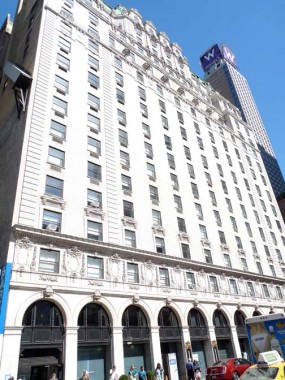
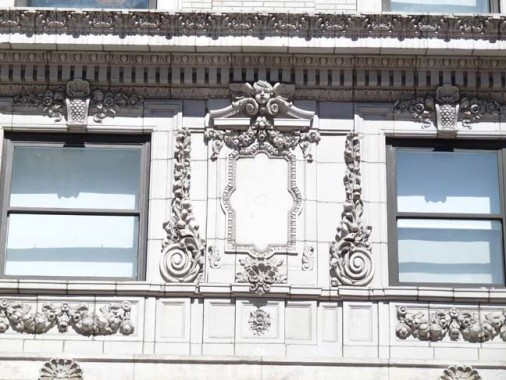
Paramount Hotel, 235 West 46th near 8th Avenue, 1928 (Thomas Lamb, architect). It was repaired and revived from 1988-1990 under ownership headed by Ian Schrager, of Studio 54 fame, and was again remodeled in 1998. Billy rose operated his Diamond Horseshoe nightclub here from 1938-1951, featuring a collection of showgirls nicknamed “Billy Rose’s Long-Stemmed Beauties.”
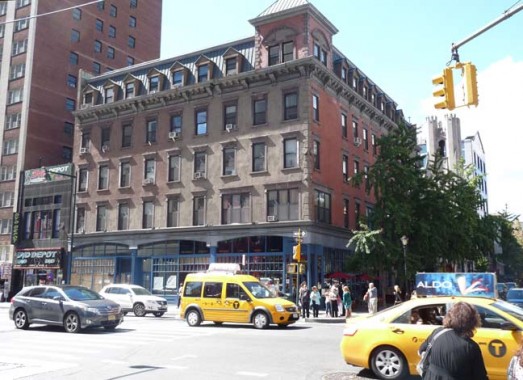
I would like to know the story behind this ancient building on the SW corner of 8th Avenue and west 46th but I can’t find anything about it. Anyone have some information?
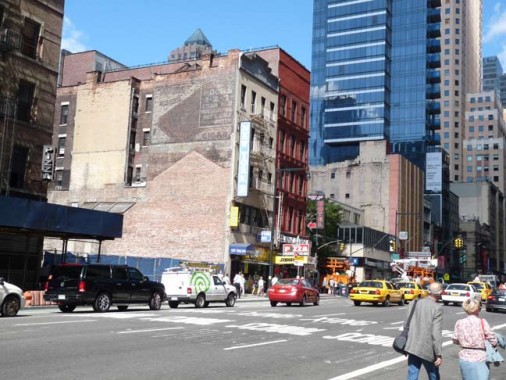
A teardown on 8th near West 46th has made an ancient advertising even more obvious — though it’s been in plain sight forever, it’s more obvious than it was…
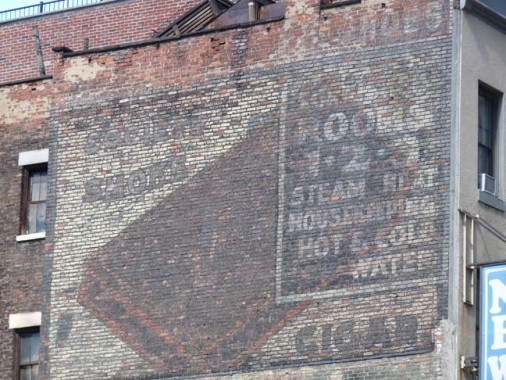
It’s three ads in the same space, likely rendered at different times. Apartments were available, 1, 2, 3 rooms, with steam heat and hot and cold water, which were not universal in the very early 20th Century. There’s something now unintelligible across the top except for the last word, SHOES. The oldest ad in the space (because the apartments ad was painted on top of it) is for Society Smoke Cigars. Perhaps the word “High” was painted over.
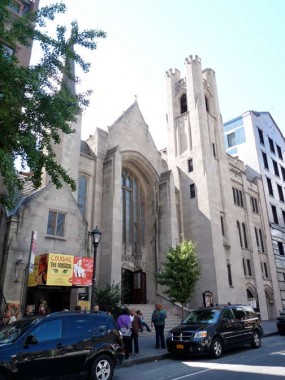
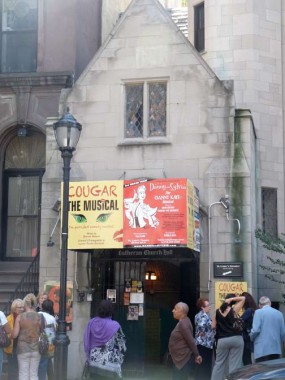
German Evangelical St. Luke’s Lutheran Church, established 1850 as a Dutch Reformed Church on West 35th Street and 9th Avenue. It reorgnized as a Lutheran Church in 1853. After several moves around Midtown the present building was dedicated in 1923 in what has been described as a Gothic-Deco amalgamation.
Two off-Broadway musicals are presented here, Cougar The Musical and Danny and Sylvia, the Danny Kaye Musical. I’m not nuts about this sort of thing, but I realize churches need income.
This block of West 46th is Restaurant Row, with a concentration of eateries and clubs catering to the pre-curtain crowd. The block has been given a decorative collection of Type B park lamps.
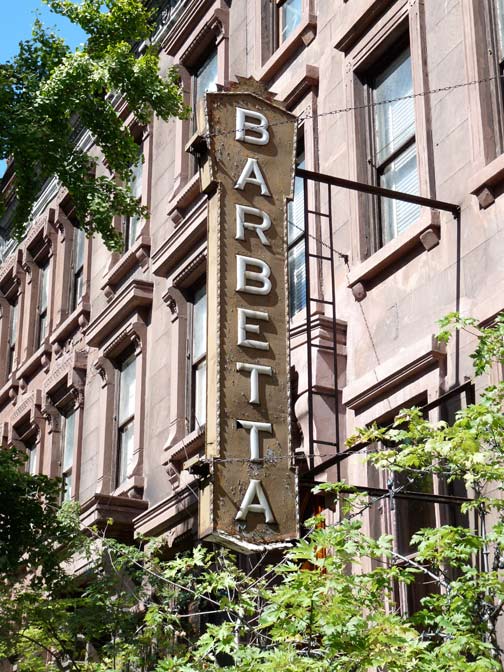
Barbetta Restaurant has been featured in a few Woody Allen movies, as well as Mad Men, and has been in business since 1906, according to its website. That sign may have been there since it moved to the present location in 1925.
Barbetta’s, so far as physical surroundings go, is simply a none-too-large, made-over private house, with a square-tiled room in the rear, jammed with uncomfortable tables and unconscionable waiters. But the Finocchio, the Veal Cotlette Parmigiana, the Scallopine of Veal al Marsala, and the curly Chicory with Barbetta dressing, are the things that have made the establishment stand out like an oasis in a desert of French Table d’hotes, one-arm cafeterias, and synthetic Italian Gardens …
Celebrities, stepping out of their divers and sundry characters during the dinner hour, flock to Barbetta’s, and half the fun of eating there is in deciding whether that thoroughly attractive gentleman on your left is really [silent film star] Richard Barthelmess or merely someone who looks tremendously like him. Nevertheless, it is the food that brings you in, and it is the food that brings you back, time and again. Rian James, Dining In New York, 1930, page 43
I’m sure I’ll have more on Midtown sometime soon…
![]() Scouting NY on Midtown’s narrowest building
Scouting NY on Midtown’s narrowest building
![]() Christopher Gray on West 46th Street
Christopher Gray on West 46th Street
10/6/12

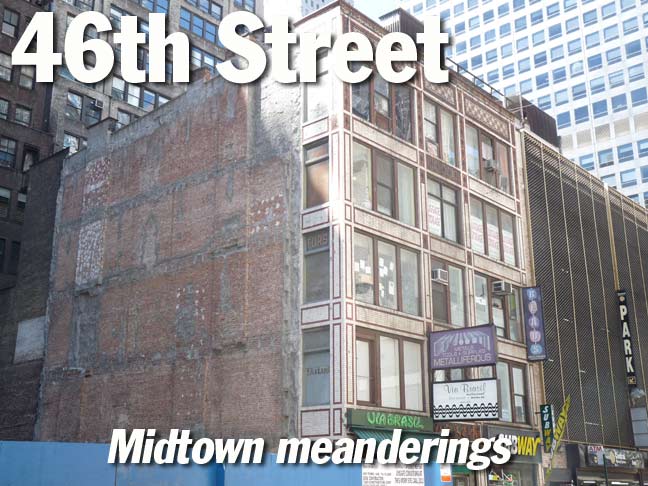
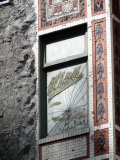

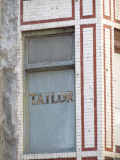
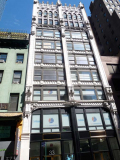
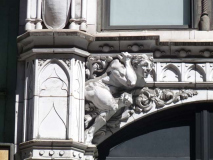
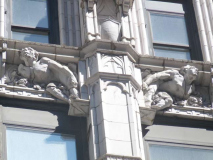
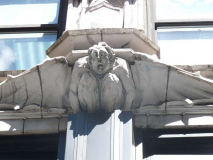
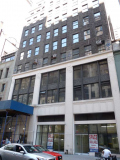
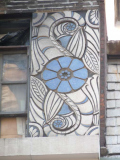
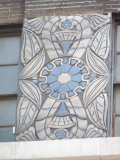
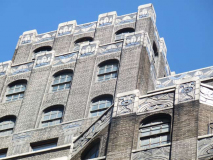
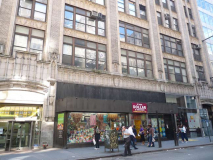
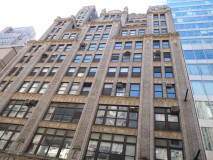
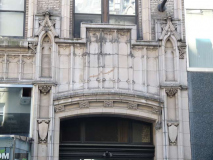
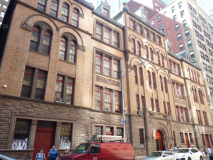
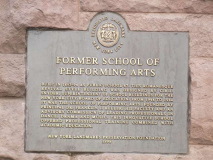

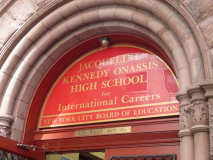
35 comments
The I. Miller store was once the shoe store for Broadway theater. They supplied many of the shoes for stage productions. The statues are tributes to some of the famous stage actresses that were repeat customers. A couple of the names might be familiar but the others are barely remembered today.
There is a McAnns on the second floor of the PA bus terminal. There was a newer one on 41st until the Times building was built.
I used to go and party in those Brazilian clubs in the mid to late 80s. I was living with a Brazilian girlfriend and humg out with her friends. It was a great little area. I think the reason for the decline was after 9-11 when the Feds started cracking down on illegal immigration, the flood of Brazilians in NYC slowed down. It was a shame because they are a good people and offered so much to the city. The Brazilians back then that were coming in illegally were mostly from Rio, Sao Paulo and Bahia. I am on the west coast now and I noticed a large number of Brazilians coming here in the last 10 years. But my ex-wife was Brazilian and back in ’96, she was like one of the few Brazilians in San Diego. Now San Diego is flooded with Brazilians but mostly from the south of Brazil and unlike the Brazilians that came to NYC in the 80s illegally looking for a better life, these Brazilians got here legally and for the most part are from families of a higher class with more money. It is unfortunate because you really can’t get into this country legally unless you have money now. Despite what all hardcore anti-immigration groups spread with their propaganda. It is very difficult to immigrate to the US unless you already have money, The whole concept of ”
“Give me your tired, your poor/Your huddled masses yearning to breathe free”, is a bumch of baloney these days. Money talks and if you don’t have it, you are not coming in without a struggle. The people that really need to come here for a better way of life and who are willing to work for it cannot get in.
Anyway, that is one of the reasons that 46th Street is quiet now with many empty storefronts for rent. In the end, when you stop people from chasing their dreams here, you also lose business and taxes that those businesses generate. It would be great if some more well to do Brazilans came back to the area and brought the life back into it. Maybe the city could give out some tax incentives to revitalize the area of Little Brasil but I doubt it will happen under the rule of Bloomberg who seems to only be concerned with knocking out the small busimess to make room for his multi-national corporate cronies and developers. I still think there is hope though! I am still a NYer and live within walking distance from the area and would love to see new life come to Little Brasil!
I seem to remember a few McAnn’s Bars between W 33rd St and Times Sq. in the area between 6th & 8th Av. In 1985 when they had New Year’s Eve free transit rides (and the NJ Transit fiasco) I walked from PATH to Times Sq and remember passing at least 2 McAnn’s Bars. We celebrated the New Year in one for about a 1/2 hour on the way back to the PATH after the ball dropped. I just don’t remember exactly where it was.
When I worked in the Chrysler Building, a frequent lunch was a brisket or pastrami on a hard roll and a beer at the McAnn’s on Lex between 44th & 45th St. Lunch was cheap and fast. The place was always packed.
There is an extensive amount of information on the upcoming redesign of the I. Miller store by the clothing company Express, along with scores of reader comments, at http://www.scoutingny.com/?p=5814 The post is entitled, “An Open Letter To Express: Will You Help Save A Times Square Treasure?”
There were several McAnns downtown in the financial district. I recall a small one at about Nassau and John. There was a larger one on Pearl which has been the Full Shilling for many years now. Tracks in Penn was once a McAnns that many commuters used to cut through to get to the LIRR when coming out of the back end of the 1/2/3 subway. We classified them as “old men” bars. Dives with sawdust on the floor which were only a minor step up from the Blarney Stone, which arguably had better food.
Very enjoyable
The building on 46th and 8th ave
once housed Joe Franklins restaurant
The word “Metalliferous” does not refer to iron. The root “fer” means “carrying,” as in containing. “Metalliferous” means that it has metal. For a similar use of that root, you might be reminded of the Carboniferous period of Earth’s history, marked by the large amount of carbon in the corresponding part of the fossil record – that layer contains a lot of carbon.
Makes sense, I put that on the page.
I started my career at a now-swallowed insurance brokerage at 46th & 6th and loved the area, in particular the remnants of the I Miller building and its’ statues by Alexander Calder’s father, and seeing it in backgound shots out the window of Spencer Tracy’s sports management office in “Pat and Mike” still brings back memories.
After being rescued from a stalled elevator in the New York Central offices at 43rd and Lex., during the great blackout of ’65, a bunch of us walked across the street to McAnn’s and spent a considerable amount of time there. I woke up around dawn in Grand Central Station – don’t remember a thing about how I got there.
There used to be a McCann’s in Grand Central, right by the shuttle entrance. I was a regular there in the late 80’s and early 90’s. They had dartboards, great bartenders and decent hot dogs. They closed just before the Grand Central restoration.
I delivered packages for UPS on West 46th Street during the 60’s
Bob, I know this post is old, but I don’t suppose you remember delivering any packages to a photo studio at 65 W. 46th, in the 60s? There was a Romanian man who lived/worked there.
Thad building on 46th and 8th used to be a Charlie Browns in the late ’90’s then became a Joe Franklin restaurant.
The building on the Southwest corner of 8th Avenue and 46th held a number of restaurants and shops. Jimmy Ray’s was there for many years.
Wasn’t 46th between 6th and 7th the old street of music instrument stores? Giardinelli, Sam Ash, were the big places, there were some other places but I don’t remember them, and now Dad is gone so I can’t ask him.
Your thinking of 48th street.
Manny’s comes to mind, (seen George Harrison checking out a few six strings there in ’74).
Building now occupied by Sam Ash (always on that block)
Terminal Music gave us a better deal on a D-35 Martin.
You can still see the old terminal “ghost sign” if you google the street the right way (one angle is older)
Many years ago, I grew up on 46th Street, not too far from Barbetta Restaurant. I always thought we had some of the most interesting buildings on 46th running between Fifth and Tenth Avenues, and a lot of interesting history and people walking by.
I always thought that was an interesting building on the SW corner – not sure who lived there, but I do recall two of the ground floor establishments. Immediately on the corner with windows facing 46th was a White Tower (similar to White Castle), and, at some point, it became a Blimpie. Next door (or maybe one more door down) was a neighborhood Irish bar; I believe it was called Kiley’s (can someone verify that?). And catty-corner, across 8th Avenue on the NE corner, was McHale’s Bar.
Luciana Govín, who underwrote the activities of José Marti, the father of independent Cuba, lived at 349 West 46th Street.
The Broadway Inn used to be on 46th and 8th, next to an Irish pub. It was an adorable Edwardian place, very “Upstairs, Downstairs,” great location, small rooms but clean, great for a single person on a short stay. It is now a parking lot.
On what I believe was the SE Corner of 46th St & 8th Ave. was my Great Grandparents Hotel and Cafe. I don’t know if the Hotel was called “The Fulton Hotel” when they had it or if it became that after their deaths. I DO know the cafe was called Mock’s and it was in business for 20+ years. I would love to know if the building still stands. It was a 4 story structure and in a 1939 tax photo, has a liquor store on the corner.
The Fulton Hotel went down sometime around the 90s or early 00s. I worked in JR Restaurant there, on the ground floor, east side of the building.
The statues on 46th and Broadway are gone! Does anyone know what happened to them?
In the 80s and 90s McAnn’s was the WalMart of bars. Instead of going to a Knick game around the time Patrick Ewing came to town I once went to a McAnn’s near Herald Square. The barmaid was about eleven months pregnant and staggering drunk. She may be a grandmom by now.
The building on the NW corner of 46th & 8th, former site of Collins’ Bar, is being torn down now. Lot of stories there; might be an interesting subject for some research.
my remembrances from the 1960s
Northeast corner of 46th and 8th – McHale’s Bar
Southeast corner: before it became the Inn, it was a rent by the hour flop house hotel – there was a liquor store on the ground floor, entrance to the hotel was on 46th
Southwest corner: a White Tower (just like White Castle), and several other sandwich type shops; I seem to recall a Blimpie
Northwest corner: an apartment house (entrance on 46th) with a night club of some sort in the basement; the stores on 8th held various businesses – I seem to remember the corner store was usually a greasy spoon; next door was a newspaper/magazine/cigarette/ice cram/candy store (not the type that sold egg creams)
When 46th between Eighth and Ninth Avenues was first designated “Restaurant Row” in 1973, the signs on each end of the stretch indicating such were white lettering on black background – the same colors as Brooklyn! (That and the black type-on-white background “Fashion Av” signs on Seventh for several blocks south of 40th were from the period of the Lindsay administration, which apparently went off the beaten track for such signs as far as the color coding went.)
I move away to florida. I could not stand land marks that made new York City what it was yanked out like a rotten tooth! Edgar Allan Poe’s house across the street what we now know as a library . It was going to be torn down to make dorms for NYU.Built as a movie palace in 1927, the Academy of Music on East 14th Street, at Third Avenue, was a place where Lower East Siders would watch first-run features in grand style. Promoter Sid Bernstein, who brought the Beatles to America, understood the 3,000-seat hall’s potential: in the mid-1960s, he regularly booked British Invasion bands like the Rolling Stones, the Kinks and Herman’s Hermits there. Manfred Mann, on the charts with “Do Wah Diddy Diddy,” would share a bill with the Exciters, the American group that first recorded the tune to little notice.
Renamed the Palladium in 1976, the hall became a full-time rock venue where the career of classic rocker Gary U.S. Bonds was jump-started after Bruce Springsteen invited him to sit in during a show. By 1985, it was converted into a nightclub; it closed in 1997 and was demolished. Today the Palladium name remains on a New York University residence hall.
But 40 years ago, on New Year’s Eve 1973, the building rocked with a lineup that featured Blue Öyster Cult and Iggy and the Stooges. Glam rockers Teenage Lust were scheduled to open the show but instead had to follow a last-minute addition: Kiss. The band that would become famous for its face paint and pyrotechnics made its big-venue debut as fire-breathing bass guitarist Gene Simmons set his hair aflame.
Here are some remembrances of that show and others. Think Academy theatre were the Beatles played the Stones KinksIggy Pop! torn down! Renamed the Palladium! I was raised in new york in 1973 I was like 7 years old. It was a real place with true artist now just yuppies thinking if they move in our homes that we wanted out of because it was a slum yuppies now rent a studio cut in half for 500 dollars. Maybe a Roach bite that bit Kieth Richards will make you like spiderman. Koroach man! It was better a slum because its now a prison!
any inside photos of 34-36 West 46th?
what bar and grills used to be at 148-150 West 45th street. I think a Loews criterion was next to them?
Club 45, where Midnight Cowboy and Owl and The Pussycat were filmed.
1978-1986 or thereabouts. McCann’s on 45th and 5th ave on 45th. You’d walk downstairs into the bar. Absolutely fantastic place for lunch and after work partying. Cunard Line has offices around the corner..on 46th street ..555 5th Avenue. After work there, we’d go to Ncanns and party all night. Great people, great times. Lucky to have experienced it!
Re. 7, West 46th St., this was once the apartment of the Danish Baron Timme Rosenkrantz who was a help to many African American jazz greats, some of whom were recorded in his apartment. In fact he’s given credit for bringing to notice the great tenor player Don Byas.
https://en.wikipedia.org/wiki/Timme_Rosenkrantz
Some of these recordings are heard on the current Mosaic 10 CD release “Classic Don Byas Sessions 1944-1945”.